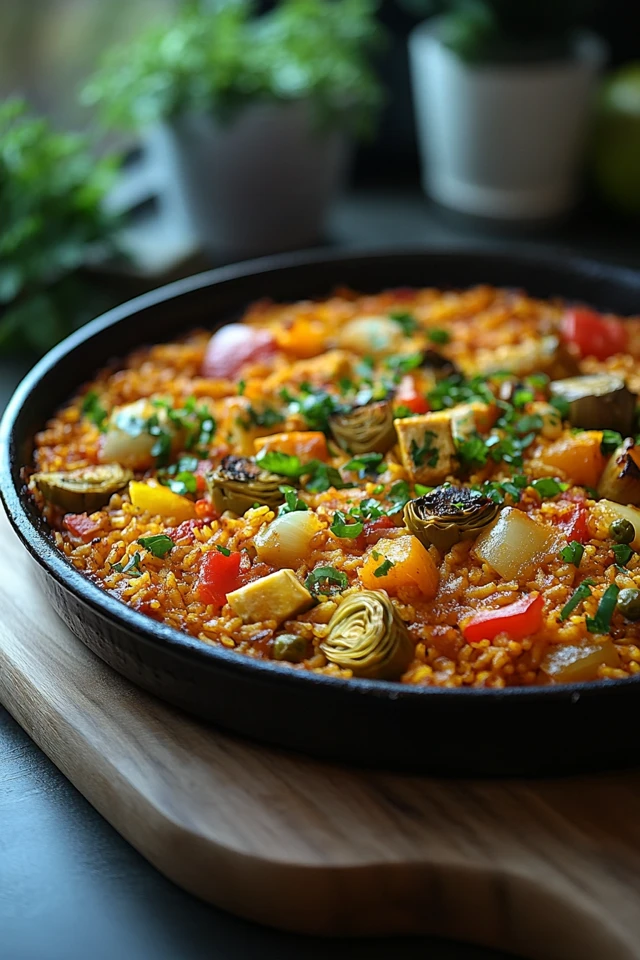Introduction
Experience the rich and colorful flavors of Spanish Vegan Paella: Vibrant & Saffron-Infused! This exquisite plant-based take on the traditional Spanish dish captures the essence of paella with its aromatic saffron-infused rice, an array of fresh vegetables, and hearty plant-based proteins. Perfect for festive gatherings, family dinners, or a delightful culinary adventure, this vegan paella promises to deliver both in taste and visual appeal.
Paella, a beloved staple of Spanish cuisine, is renowned for its harmonious blend of flavors and vibrant presentation. Our vegan version maintains this authenticity by utilizing wholesome, plant-based ingredients that offer a satisfying and nutritious meal without compromising on tradition. Whether you’re a seasoned vegan or simply exploring plant-based options, this Spanish Vegan Paella offers a delightful combination of textures and tastes that cater to all palates. In this comprehensive guide, we’ll delve into the benefits of vegan paella, provide a detailed recipe, and share tips and variations to customize it to your liking. Let’s embark on a culinary journey to create a vibrant and saffron-infused vegan Spanish paella that will become a favorite in your kitchen!
Why Choose Spanish Vegan Paella?
Opting for Spanish Vegan Paella offers a multitude of benefits that cater to health, ethical, and culinary preferences. Here’s why this dish should become a staple in your meal planning:
Health-Conscious Choice
- Nutrient-Rich: Loaded with fresh vegetables, legumes, and plant-based proteins, this paella provides a balanced mix of vitamins, minerals, and antioxidants essential for overall health.
- Heart-Healthy Fats: The use of olive oil introduces heart-healthy monounsaturated fats, promoting cardiovascular health and satiety.
- High in Fiber: Brown rice and an abundance of vegetables contribute to a high fiber content, aiding in digestion and promoting sustained energy levels.
- Antioxidant Properties: Ingredients like saffron, bell peppers, and tomatoes are rich in antioxidants that help combat free radicals, reduce inflammation, and support immune function.
Ethical and Sustainable
- Plant-Based: Embracing a plant-based meal reduces your carbon footprint and supports sustainable eating practices, benefiting both your health and the environment.
- Cruelty-Free: Free from animal products, this paella aligns with compassionate lifestyle choices and ethical food preferences.
Versatile and Customizable
- Flavor Adjustments: Easily tweak the seasoning and ingredients to suit your taste preferences, whether you prefer a spicier kick or a more savory profile.
- Ingredient Flexibility: Substitute or add various vegetables, legumes, or herbs based on availability and personal preferences, making the recipe adaptable to various dietary needs.
- Serving Options: Serve as a standalone meal, alongside a fresh green salad, or as part of a larger Mediterranean-inspired spread for added variety and balance.
Delicious and Satisfying
- Balanced Flavors: The combination of aromatic saffron rice, savory vegetables, and hearty proteins creates a balanced and satisfying flavor profile that delights the palate.
- Elegant Presentation: A well-prepared paella not only tastes amazing but also looks visually stunning, making it perfect for both everyday meals and special occasions.
Ingredients
Creating Spanish Vegan Paella involves a harmonious blend of aromatic spices, fresh vegetables, hearty legumes, and flavorful plant-based proteins. Here’s what you’ll need:
For the Paella
- Brown Rice: 2 cups (short-grain preferred for authenticity)
- Olive Oil: 3 tablespoons
- Onion: 1 large, finely chopped
- Garlic Cloves: 4, minced
- Bell Peppers: 2 large (different colors), sliced into strips
- Tomatoes: 3 medium, diced
- Zucchini: 2 medium, sliced into half-moons
- Green Beans: 1 cup, trimmed
- Artichoke Hearts: 1 can (14 oz), drained and quartered
- Chickpeas: 1 can (15 oz), drained and rinsed
- Vegetable Broth: 6 cups (low-sodium preferred)
- Saffron Threads: 1 teaspoon, soaked in 2 tablespoons of warm water
- Smoked Paprika: 1 teaspoon
- Turmeric Powder: 1/2 teaspoon (for color)
- Salt: 1 teaspoon (adjust to taste)
- Black Pepper: 1/2 teaspoon
- Lemon Wedges: For serving
- Fresh Parsley: 1/4 cup, chopped (for garnish)
Optional Add-ins and Toppings
- Vegan Sausage: 1 package, sliced (for added protein)
- Peas: 1 cup, frozen or fresh
- Olives: 1/2 cup, sliced (for a briny contrast)
- Sun-Dried Tomatoes: 1/4 cup, chopped
- Red Pepper Flakes: 1/4 teaspoon (for a spicy kick)
- Pine Nuts or Almonds: 2 tablespoons, toasted (for added crunch)
- Roasted Red Peppers: 1 cup, sliced (for depth of flavor)
Ingredient Breakdown
- Brown Rice: Serves as the hearty and nutritious base of the paella, providing complex carbohydrates and fiber.
- Saffron Threads: Infuse the rice with a distinct aroma and vibrant yellow hue, essential for authentic paella flavor.
- Fresh Vegetables: Bell peppers, zucchini, green beans, and artichoke hearts contribute a variety of textures, colors, and nutrients.
- Legumes: Chickpeas add protein and a creamy texture, enhancing the paella’s heartiness.
- Spices: Smoked paprika and turmeric offer depth and color, while garlic and onion build a savory foundation.
- Optional Add-ins: Vegan sausage, peas, olives, and sun-dried tomatoes allow for customization and added layers of flavor and texture.
Instructions
Preparing Spanish Vegan Paella is straightforward and yields a delicious, nutritious meal perfect for any occasion. Follow these step-by-step instructions to create a vibrant and saffron-infused paella in about 1 hour and 15 minutes.
Step 1: Prepare the Saffron
- Soak the Saffron:
- In a small bowl, combine 1 teaspoon of saffron threads with 2 tablespoons of warm water. Let it soak for at least 10 minutes to release its color and flavor.
Step 2: Sauté the Aromatics
- Heat the Olive Oil:
- In a large paella pan or a wide, deep skillet, heat 3 tablespoons of olive oil over medium heat.
- Cook the Onions and Garlic:
- Add the finely chopped onion to the pan and sauté for about 5 minutes until translucent and soft.
- Stir in the minced garlic and cook for an additional 1-2 minutes until fragrant.
Step 3: Add the Vegetables
- Incorporate Bell Peppers and Zucchini:
- Add the sliced bell peppers and zucchini to the pan. Sauté for about 5 minutes until they begin to soften.
- Add Tomatoes and Green Beans:
- Stir in the diced tomatoes and green beans, cooking for another 3-4 minutes until the tomatoes start to break down.
Step 4: Add the Rice and Spices
- Mix in the Rice:
- Add 2 cups of brown rice to the pan, stirring to coat the grains with the oil and vegetables.
- Season the Mixture:
- Sprinkle in the smoked paprika, turmeric powder, salt, and black pepper. Mix well to ensure the spices are evenly distributed.
Step 5: Add the Broth and Saffron
- Pour in the Broth:
- Gradually add 6 cups of vegetable broth to the pan, stirring to combine all ingredients.
- Add the Saffron Infusion:
- Pour the saffron-infused water into the paella, stirring gently to distribute the flavor and color.
Step 6: Cook the Paella
- Bring to a Simmer:
- Increase the heat to medium-high and bring the mixture to a gentle simmer.
- Add Artichoke Hearts and Chickpeas:
- Stir in the quartered artichoke hearts and drained chickpeas, ensuring they are evenly distributed throughout the rice.
- Simmer Without Stirring:
- Reduce the heat to low and let the paella simmer uncovered for about 40-45 minutes, or until the rice is tender and has absorbed most of the liquid. Avoid stirring to allow the formation of a crispy socarrat (bottom crust), a prized feature of authentic paella.
- Add Optional Vegetables and Proteins:
- In the last 10 minutes of cooking, incorporate any optional add-ins like vegan sausage, peas, olives, or sun-dried tomatoes for enhanced flavor and texture.
Step 7: Final Touches
- Check for Doneness:
- Ensure the rice is fully cooked and the vegetables are tender. If the paella is too dry, add a little more vegetable broth or water as needed.
- Rest the Paella:
- Remove the pan from heat and cover it with a clean kitchen towel or aluminum foil. Let it rest for about 5-10 minutes to allow the flavors to meld.
Step 8: Serve and Garnish
- Garnish the Paella:
- Sprinkle freshly chopped parsley over the top for a burst of color and freshness.
- Add toasted pine nuts or almonds for a delightful crunch.
- Serve with lemon wedges on the side for an extra zing.
- Enjoy:
- Serve the Spanish Vegan Paella hot, ensuring each portion has a generous mix of rice, vegetables, and protein.
Tips and Variations
Enhance your Spanish Vegan Paella with these helpful tips and creative variations:
1. Customize the Protein
- Jackfruit: Substitute chickpeas with shredded jackfruit for a meatier texture.
- Tofu or Tempeh: Add marinated and sautéed tofu or tempeh for additional protein and flavor.
2. Experiment with Vegetables
- Eggplant: Incorporate diced eggplant for a rich and hearty addition.
- Peas: Add green peas for a pop of sweetness and color.
3. Enhance the Flavor
- Smoked Paprika: Increase the amount of smoked paprika for a deeper smoky flavor.
- Herbs: Add fresh thyme or rosemary during cooking for an aromatic twist.
4. Make It One-Pan
- Sheet Pan Method: Use a large baking sheet to cook the paella in the oven for an even distribution of heat and enhanced socarrat formation.
5. Incorporate Legumes
- Lentils: Add cooked green or brown lentils for an extra protein and fiber boost.
- Black Beans: Incorporate black beans for a different texture and flavor profile.
6. Adjust the Spice Level
- Red Pepper Flakes: Add a pinch of red pepper flakes for a mild heat.
- Hot Sauce: Drizzle your favorite hot sauce over the finished paella for an extra kick.
7. Use Different Grains
- Quinoa: Substitute brown rice with quinoa for a gluten-free and protein-rich alternative.
- Farro or Barley: Experiment with other whole grains like farro or barley for a unique texture.
8. Add a Citrusy Twist
- Lemon Zest: Add lemon zest to the broth for a refreshing citrus note.
- Orange Slices: Garnish with thin orange slices for an unexpected burst of flavor.
9. Make It Ahead
- Prep in Advance: Prepare and chop all vegetables and proteins ahead of time to streamline the cooking process.
- Store Properly: Store leftovers in an airtight container in the refrigerator for up to 3 days. Reheat gently on the stovetop, adding a splash of broth if needed.
10. Enhance Presentation
- Layered Platter: Serve the paella on a large, shallow platter, arranging toppings neatly for an elegant presentation.
- Individual Portions: Spoon individual servings into small bowls for a personalized touch.
Nutritional Information
Understanding the nutritional profile of your meals helps you make informed dietary choices. Here’s the approximate nutritional breakdown for one serving of the Spanish Vegan Paella (serves 6):
Per Serving:
- Calories: 450 kcal
- Protein: 14g
- Carbohydrates: 60g
- Fiber: 9g
- Fat: 15g
- Saturated Fat: 3g
- Sugar: 7g
- Sodium: 800mg
Nutritional Highlights:
- High in Fiber and Protein: Brown rice and chickpeas provide a substantial fiber and protein boost, promoting digestive health and muscle maintenance.
- Heart-Healthy Fats: Olive oil and pine nuts contribute heart-healthy monounsaturated and polyunsaturated fats essential for cardiovascular health and satiety.
- Vitamins and Minerals: A variety of vegetables supply vitamins A and C, potassium, iron, and magnesium, supporting various bodily functions.
- Antioxidants: Ingredients like saffron, bell peppers, and tomatoes are loaded with antioxidants that combat oxidative stress and support immune function.
Adjusting Nutritional Content:
- Lowering Calories: Reduce the amount of olive oil used or opt for a spray oil to minimize fat content. Incorporate more low-calorie vegetables like broccoli or mushrooms for added volume without extra calories.
- Increasing Protein: Add more plant-based proteins like additional chickpeas, tofu, or tempeh into the paella.
- Reducing Sodium: Use low-sodium soy sauce or tamari and adjust the added salt based on your dietary needs. Incorporate more herbs and spices to enhance flavor without relying solely on salt.
Conclusion
The Spanish Vegan Paella: Vibrant & Saffron-Infused is a perfect blend of health-conscious ingredients and bold, satisfying flavors, making it an ideal addition to any meal plan. This dish not only caters to vegan and gluten-free dietary needs but also provides a wholesome and visually stunning option that supports your health and well-being.
Whether you’re preparing a family dinner, hosting a festive party, or looking for a nutritious and elegant meal, this paella offers versatility, ease of preparation, and endless customization options to suit your preferences. Embrace the vibrant flavors of Spanish cuisine with the aromatic infusion of saffron and the hearty goodness of plant-based proteins in this delightful recipe that celebrates the best of wholesome and flavorful plant-based cooking.
Enjoy the process of sautéing, simmering, and layering your paella, and savor each bite knowing you’re nourishing your body with wholesome, plant-based goodness. Here’s to creating and enjoying meals that bring joy, health, and a burst of color to your table!
Picture Gallery
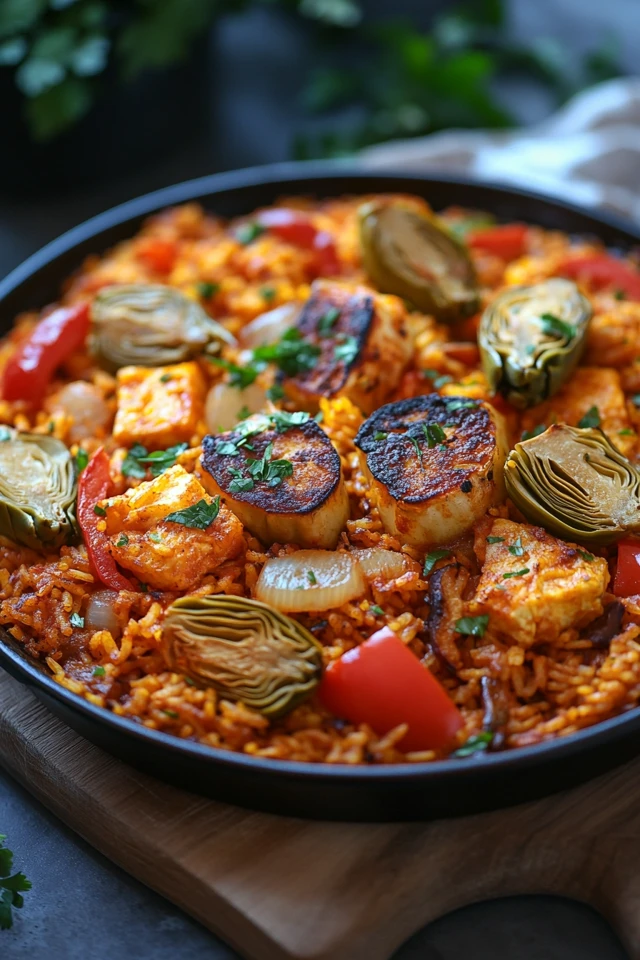
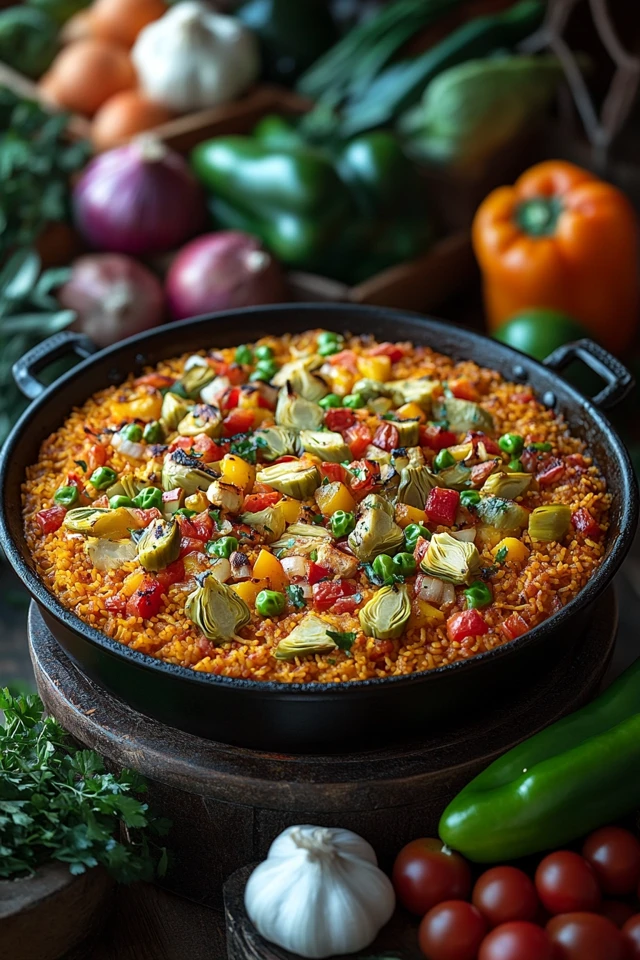
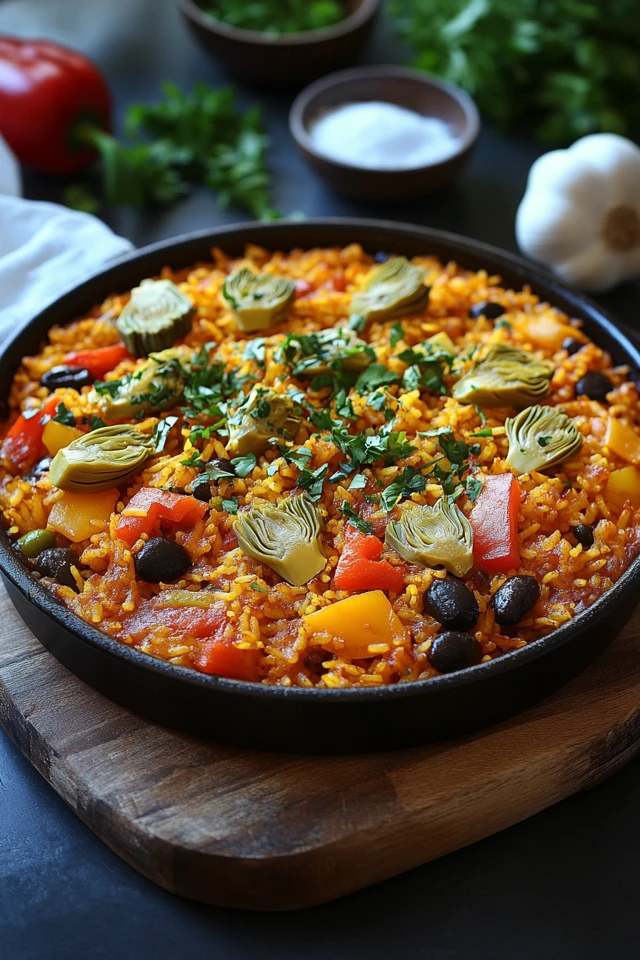
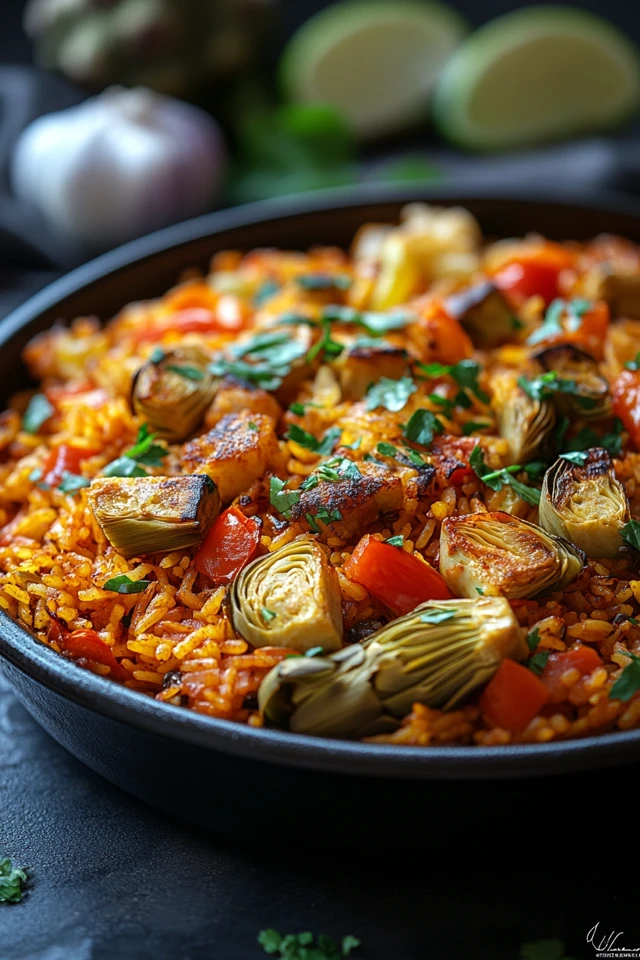
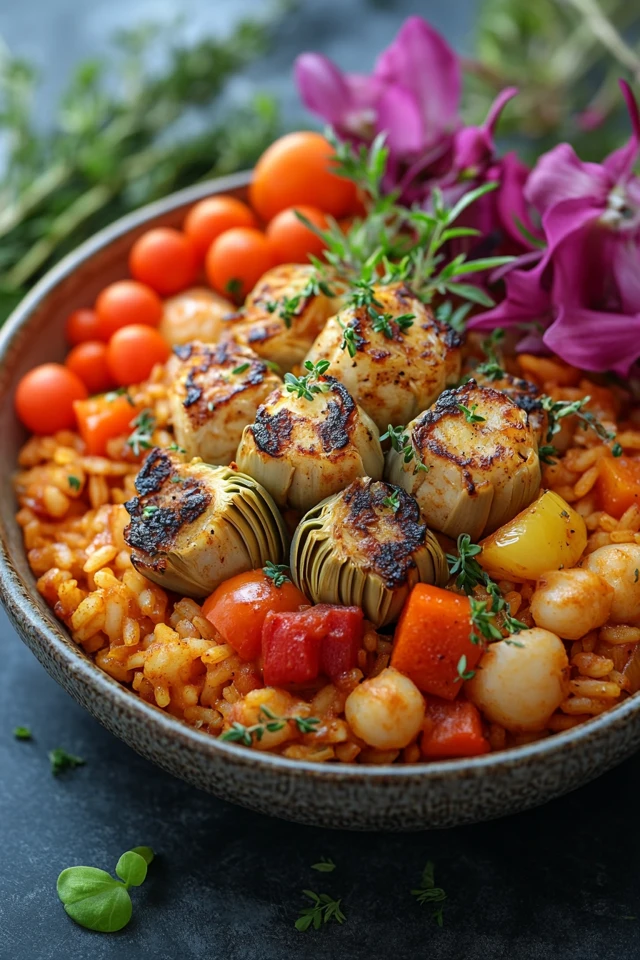
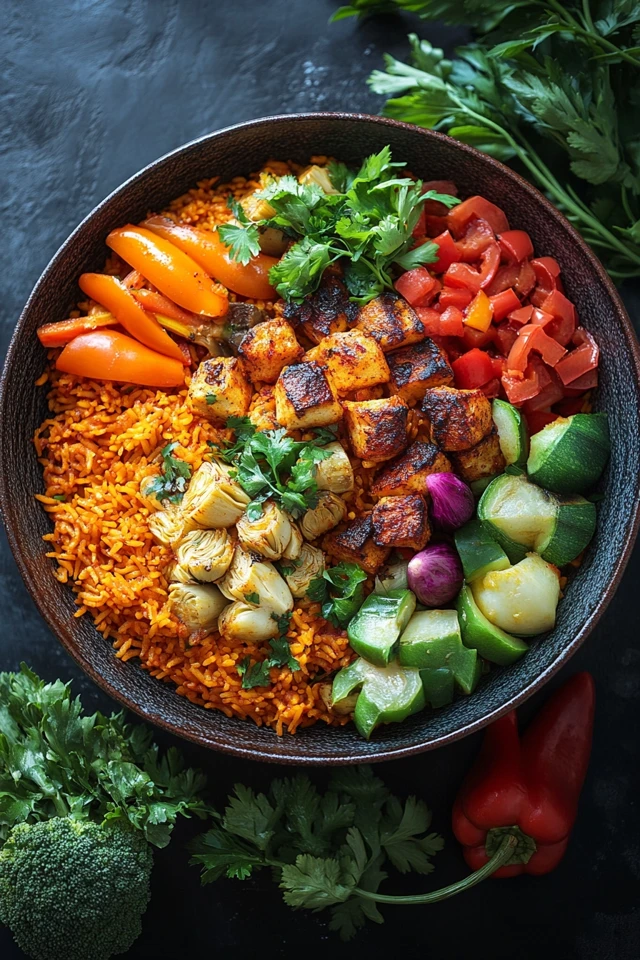
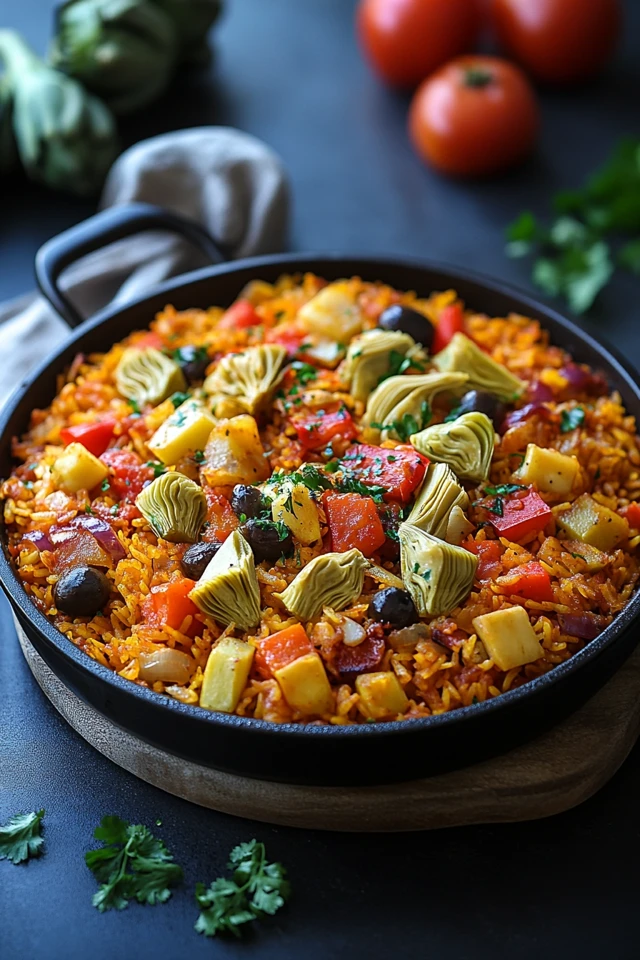
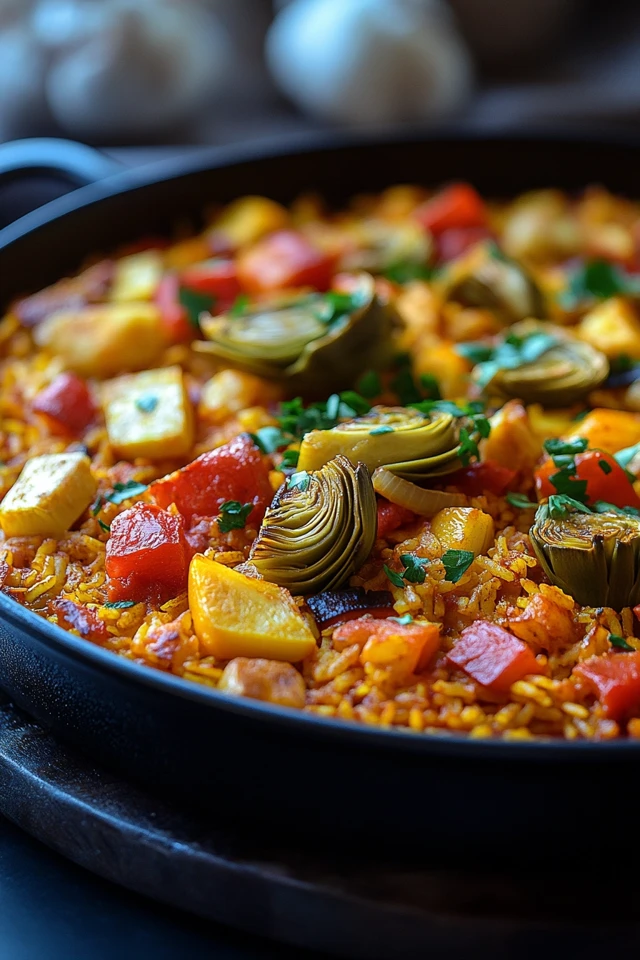
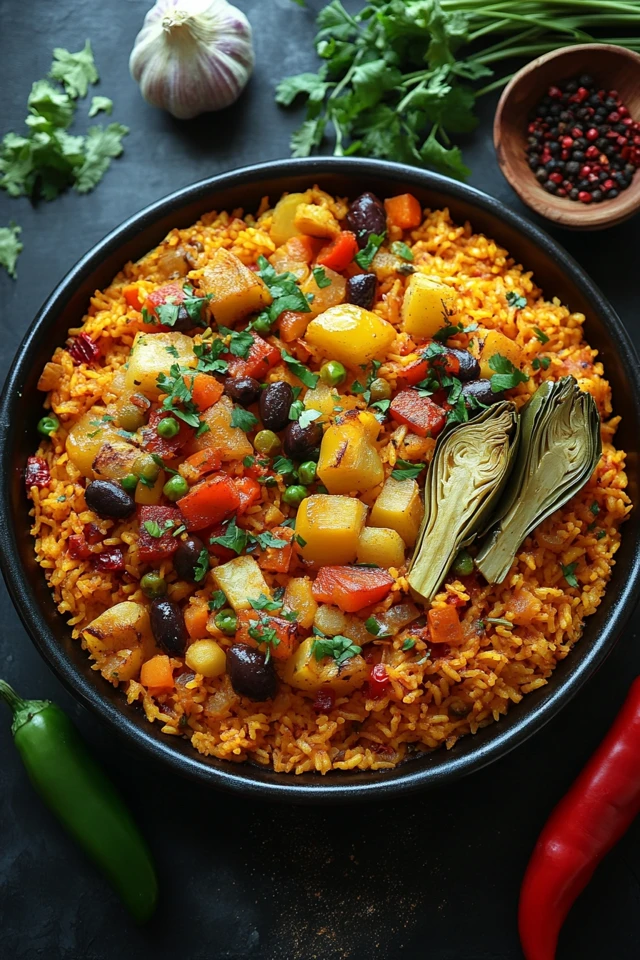
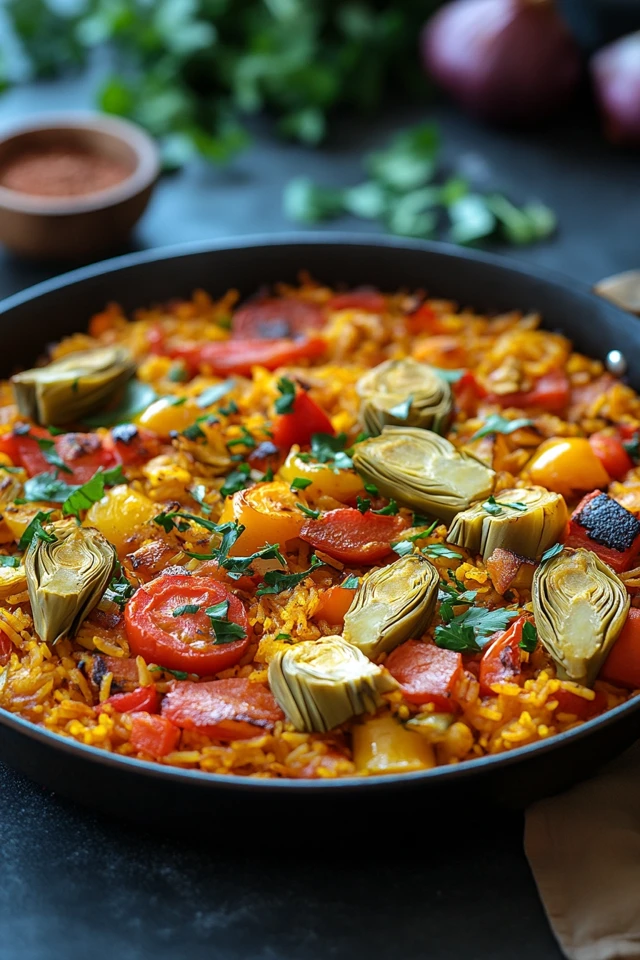
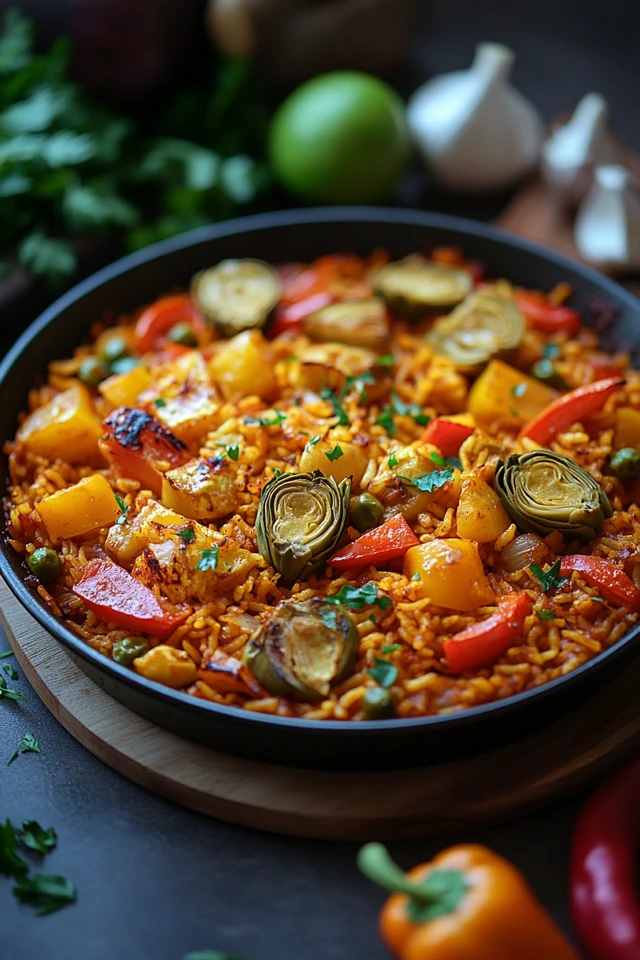
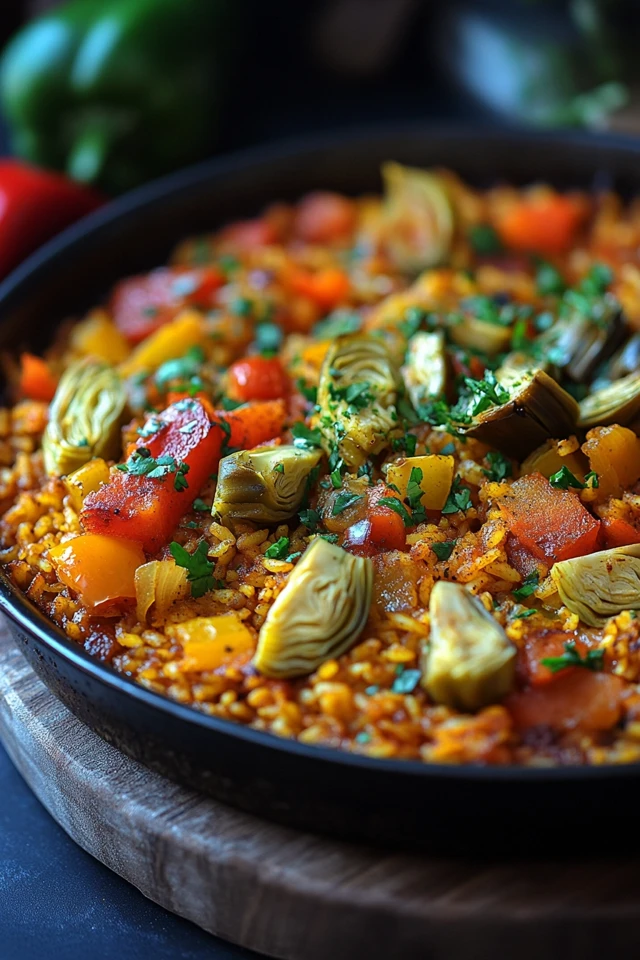
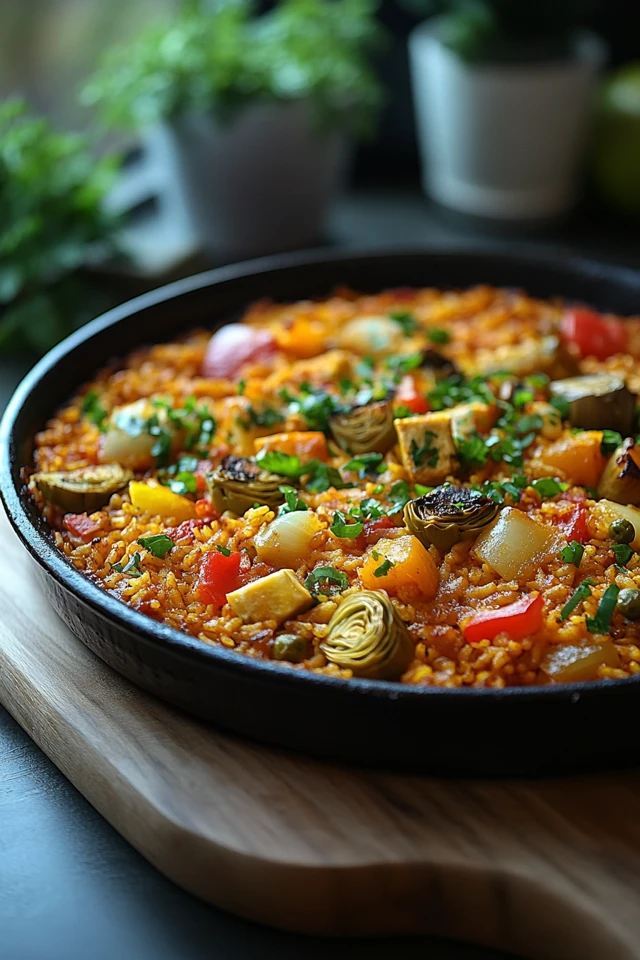
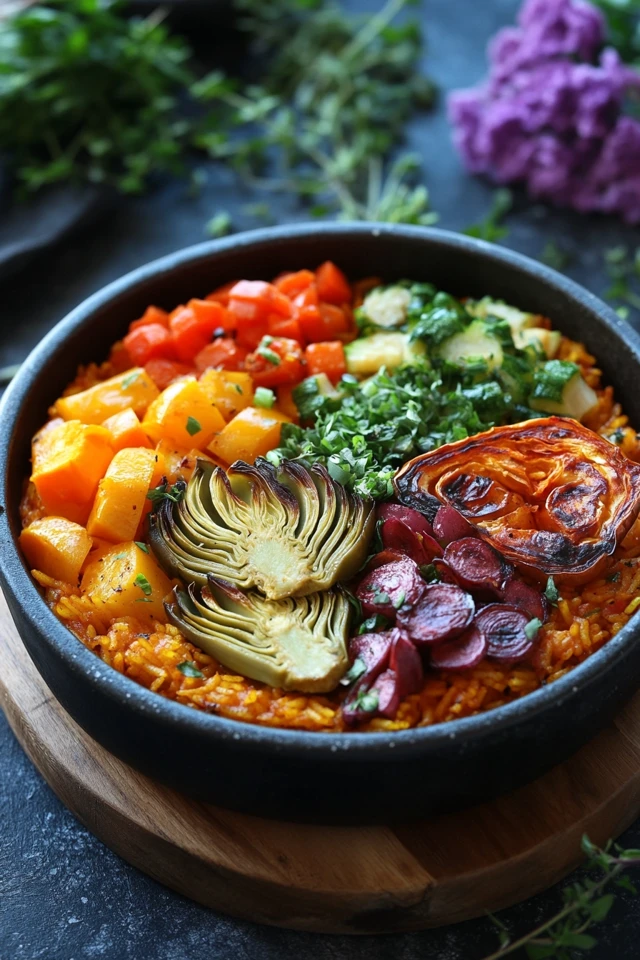
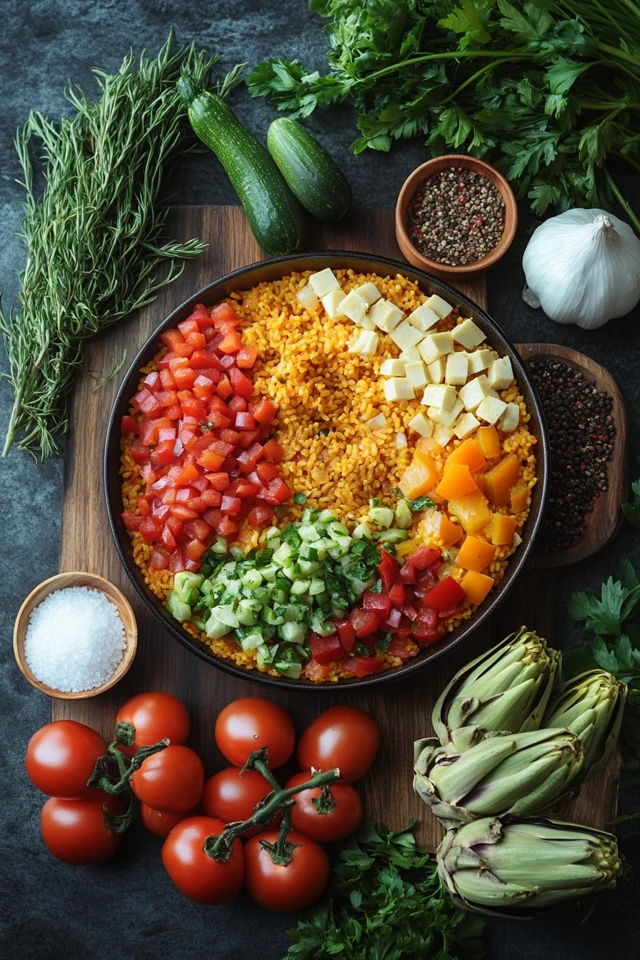
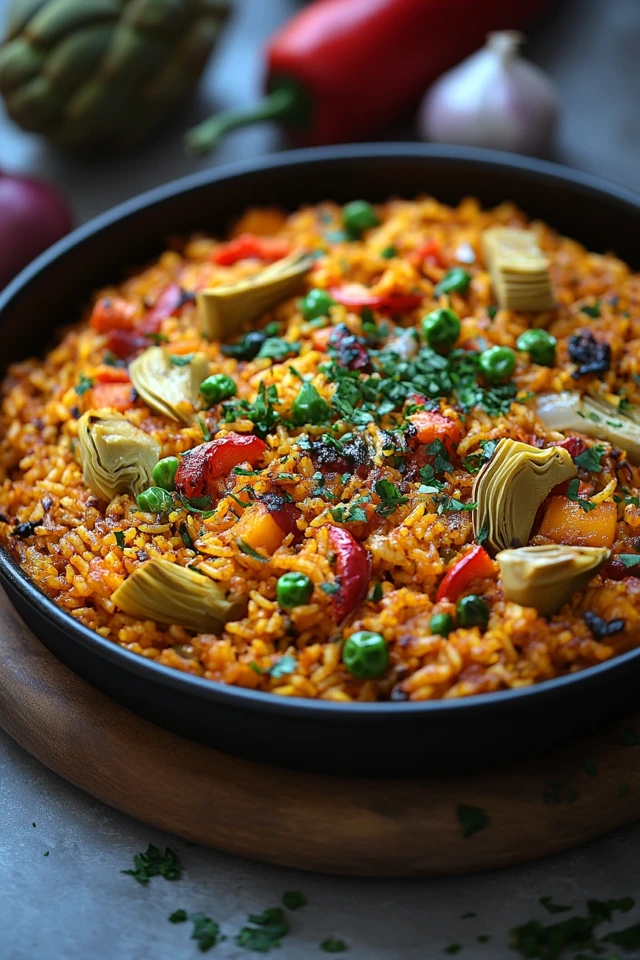
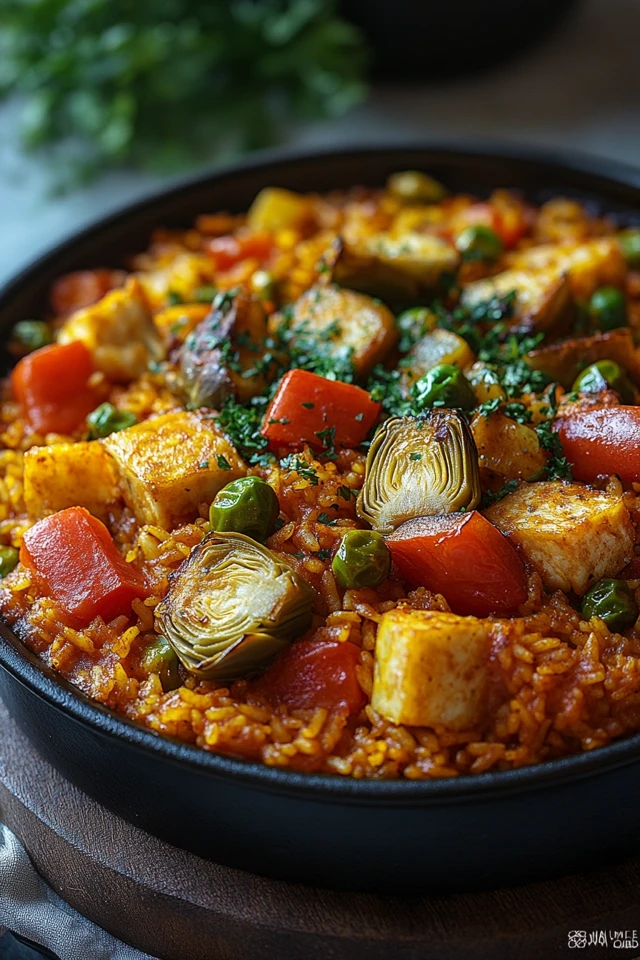
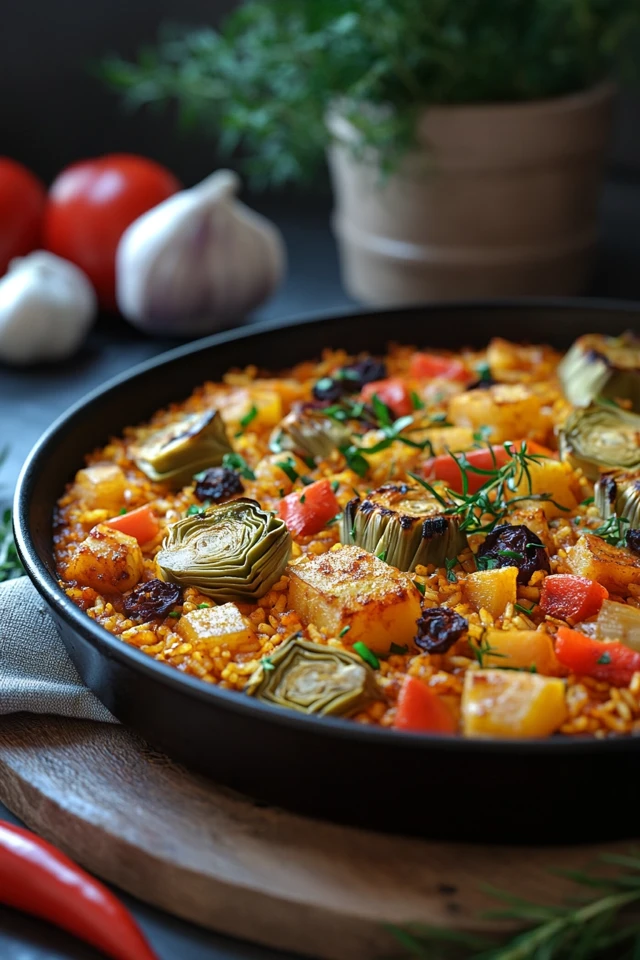
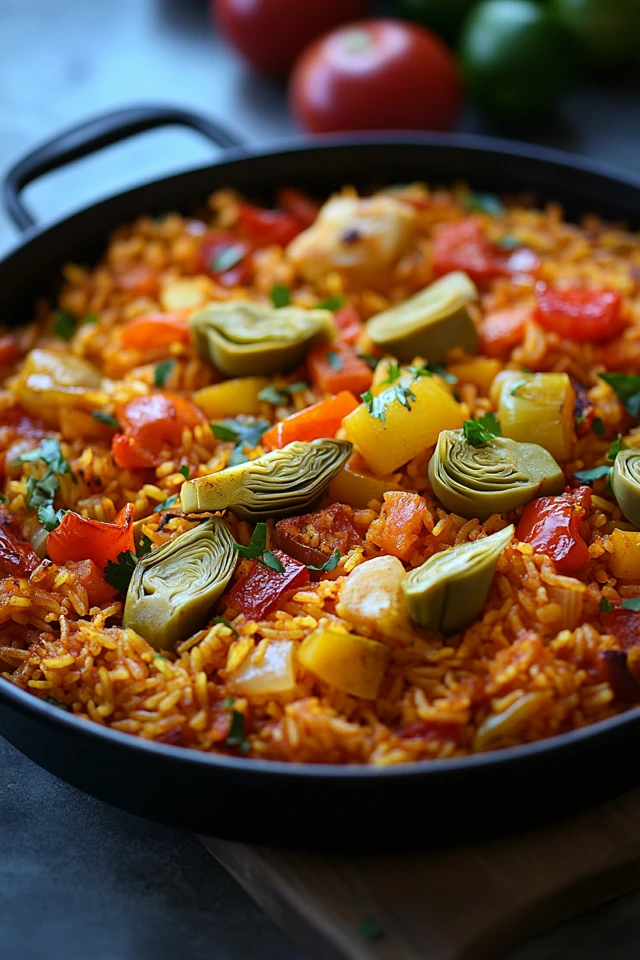
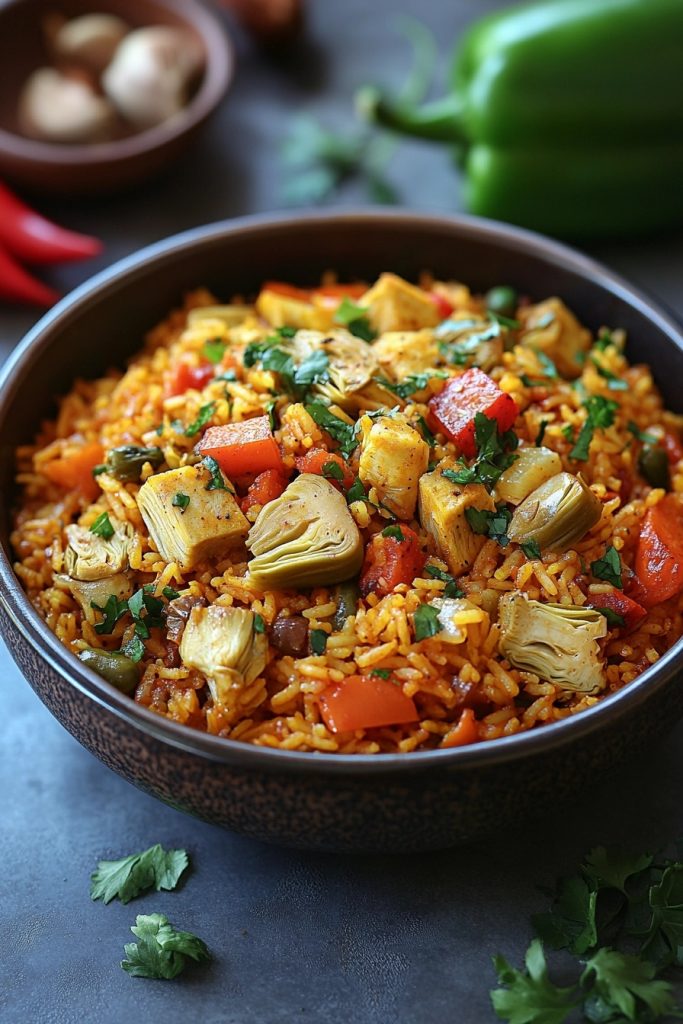
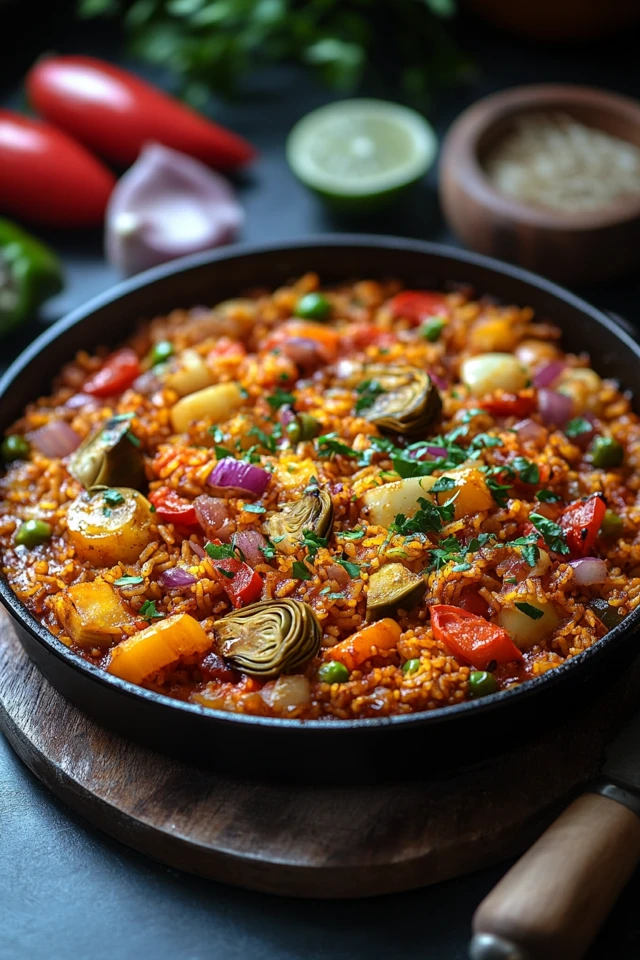
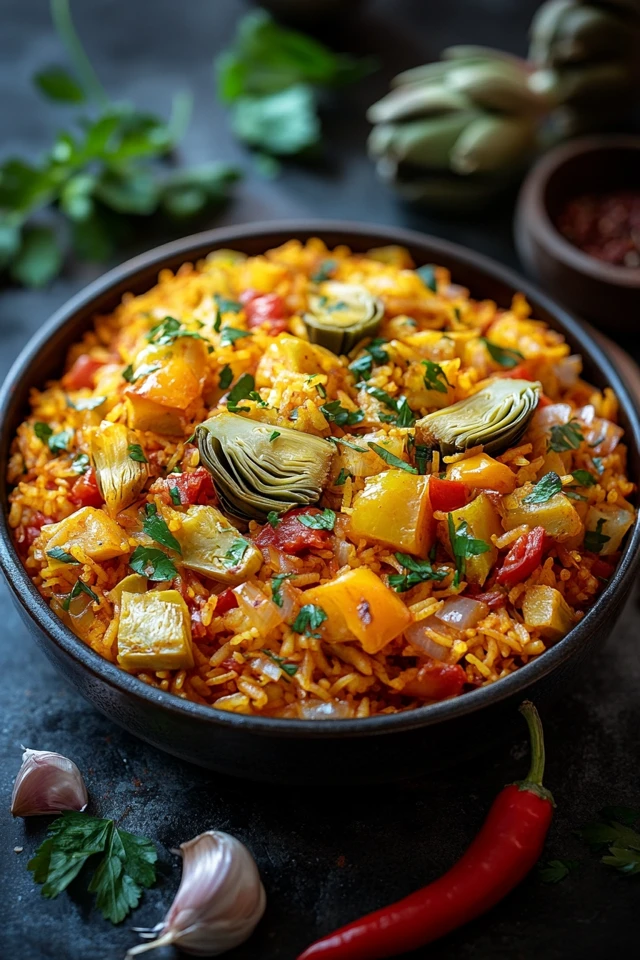
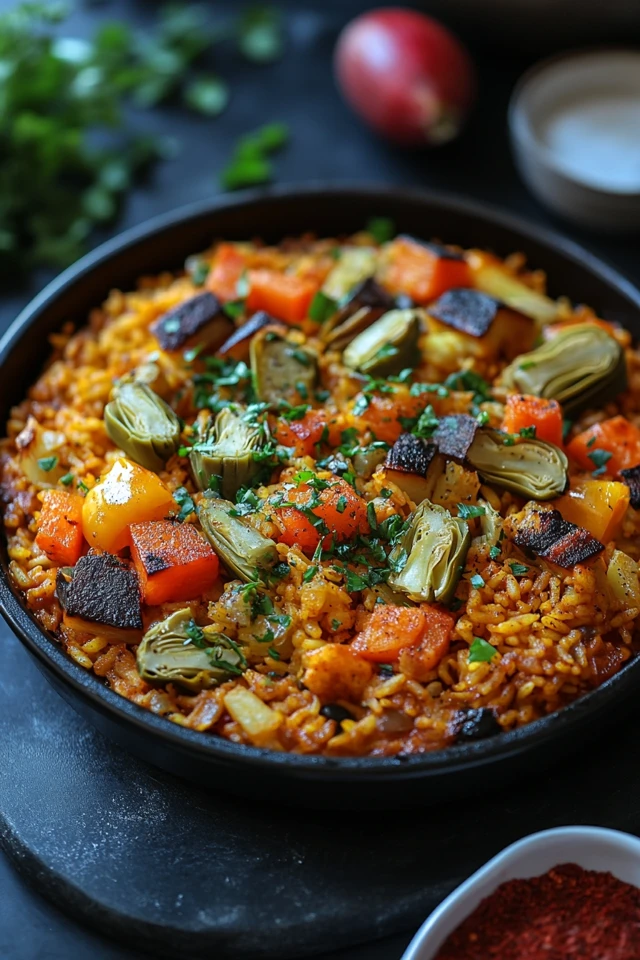
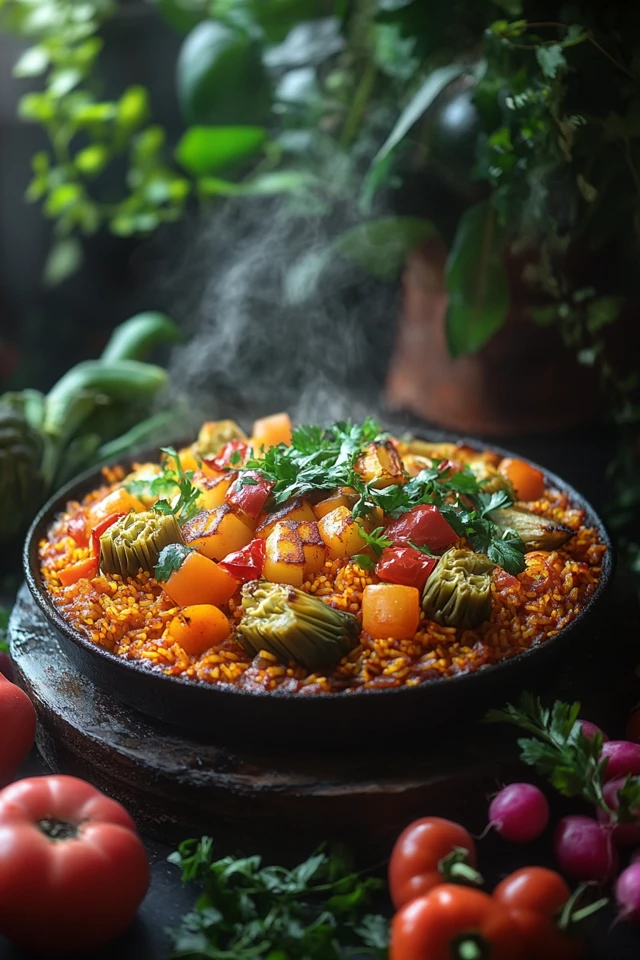
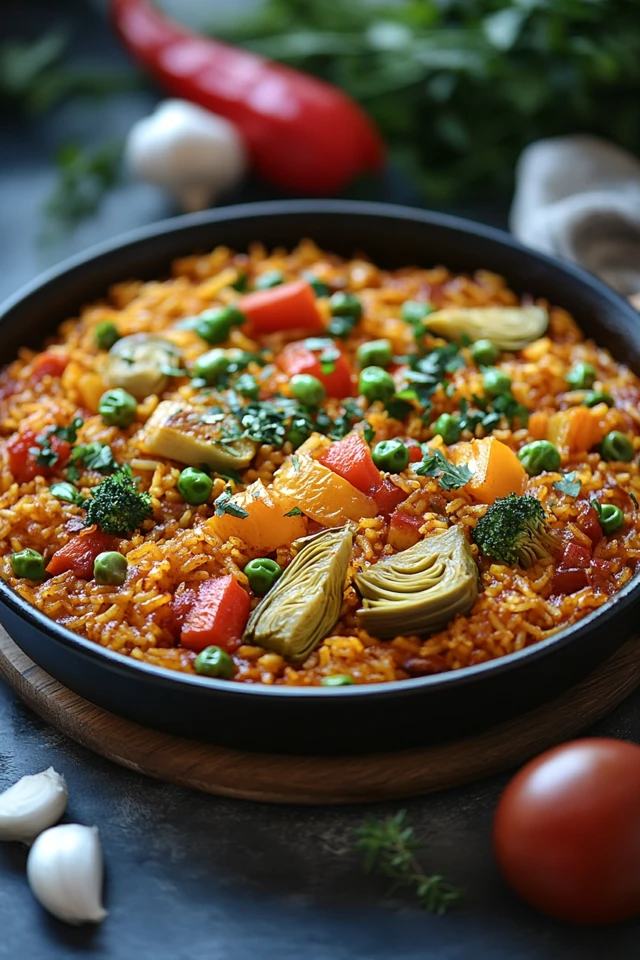
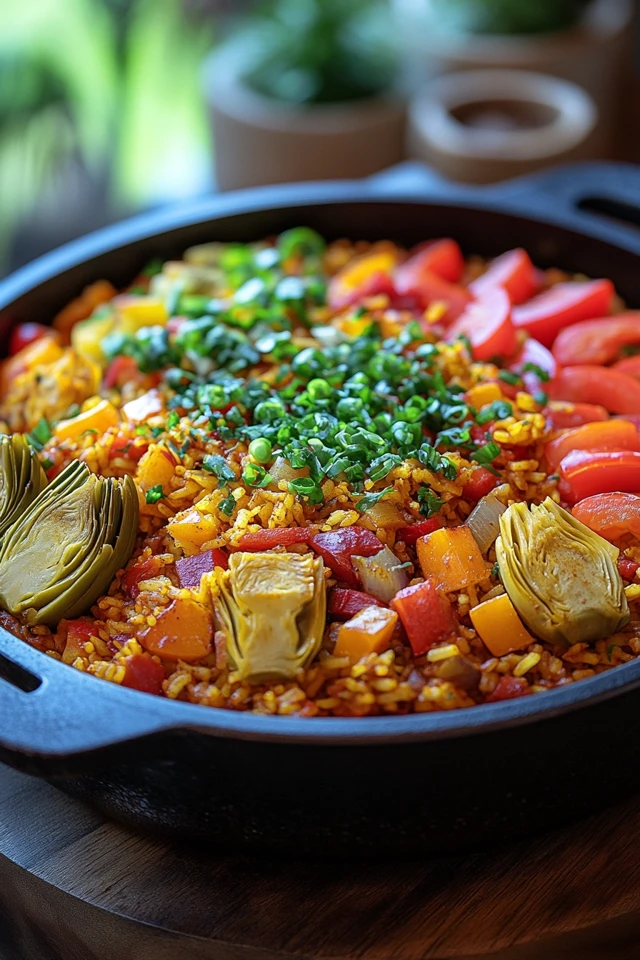
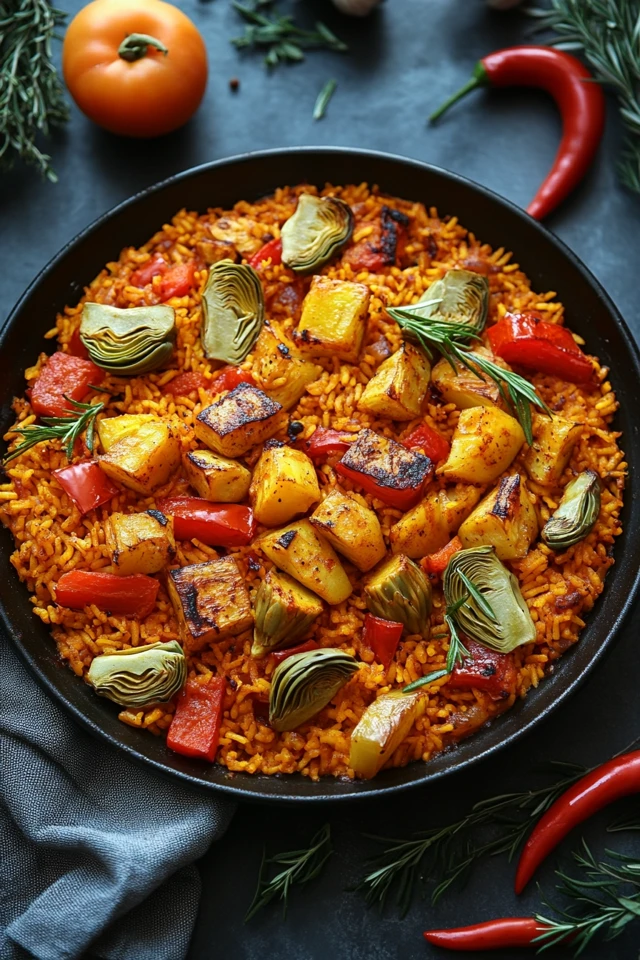
Frequently Asked Questions (FAQs)
1. Can I make this paella ahead of time?
Absolutely! Spanish Vegan Paella can be prepared a day ahead. Allow the paella to cool completely, then store it in an airtight container in the refrigerator. Reheat gently on the stovetop, adding a splash of vegetable broth or water if the rice has absorbed too much liquid.
2. What can I use as a plant-based protein substitute?
You can use jackfruit, tofu, seitan, or tempeh as plant-based protein substitutes. Each option offers a different texture and flavor:
- Jackfruit: Provides a shredded, meat-like texture.
- Tofu: Offers a firm and versatile protein that absorbs flavors well.
- Seitan: Delivers a chewy and hearty texture similar to traditional meat.
- Tempeh: Adds a nutty flavor and firm texture.
3. Is this recipe gluten-free?
Yes! By using tamari instead of regular soy sauce and ensuring that all other ingredients, including the pasta and any optional add-ins, are gluten-free, you can easily make this paella gluten-free. Always check labels to confirm the gluten-free status of store-bought products.
4. How can I make the paella more flavorful?
To enhance the flavor of your paella, consider adding a splash of white wine or vermouth to the broth for depth. Incorporate more aromatics like lemongrass or bay leaves during cooking, or use a smoked paprika for an extra smoky undertone.
5. Can I add more vegetables to the paella?
Absolutely! Feel free to incorporate additional vegetables like broccoli, mushrooms, artichokes, or sweet potatoes to increase the nutritional value and add more texture to your paella.
6. How do I achieve the crispy socarrat (bottom crust)?
To achieve a crispy socarrat, cook the paella over medium heat without stirring for the last 5-10 minutes of simmering. Allow the bottom layer to caramelize and form a crispy crust. You can also finish the paella under a broiler for a few minutes to enhance the crust.
7. Can I use different types of rice?
Yes! While brown rice is preferred for its nuttier flavor and higher fiber content, you can use short-grain white rice or arborio rice as substitutes. Adjust the cooking time and liquid ratio accordingly based on the rice type.
8. How do I store leftovers?
Store any leftover paella in an airtight container in the refrigerator for up to 3 days. Reheat it gently on the stovetop or in the microwave, adding a little vegetable broth or water to loosen the rice if it has become too dry.
9. Can I make the paella vegan without soy?
Yes! You can make the paella vegan without soy by using protein substitutes like jackfruit, mushrooms, or chickpeas instead of tofu or tempeh. Ensure that all other ingredients, including the broth and any optional add-ins, are free from animal products.
10. What can I serve alongside this vegan paella?
Serve your Spanish Vegan Paella alongside traditional Spanish sides like a fresh green salad, roasted vegetables, garlic bread, or a bowl of gazpacho for a complete and satisfying meal. They also pair wonderfully with a glass of sangria or a crisp white wine for an elegant dining experience.
About the Author
Welcome to Vegan & Plant-Based Kitchen! I’m Julio Arco, a passionate vegan chef dedicated to creating delicious, easy-to-make plant-based recipes that nourish both body and soul. Since embracing a vegan lifestyle in 2010, I’ve been on a culinary journey to explore the endless possibilities of plant-based cooking. From vibrant salads to hearty mains and indulgent desserts, my mission is to inspire and empower you to embrace a compassionate and healthy lifestyle through wholesome food.
Join me on this journey as we explore diverse flavors, experiment with fresh ingredients, and celebrate the beauty of plant-based living. Let’s create, share, and enjoy the goodness of vegan cooking together!
Disclaimer: This blog post is intended for informational purposes only. Always consult with a healthcare professional before making significant changes to your diet.

